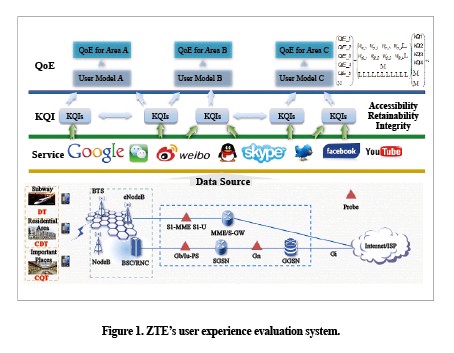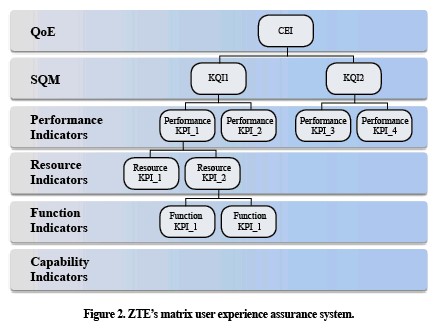ZTE’s UniCare User Experience Assurance System
Every network operator is concerned about user experience, but there is no standard for it. User experience can be improved by eliminating faults or increasing network coverage. However, these event-triggered approaches to improving user experience have many drawbacks. Problems are only solved after the negative effect occurs and user satisfaction declines. Also, potential problems that may affect user experience cannot be identified and solved. User requirements and network problems vary widely; therefore, a range of appropriate methods are required to precisely evaluate user experience, determine factors that may affect user experience, and promptly improve user experience.
Network KPI
Operators mainly focus on network KPIs, such as statistical indicators including call completion ratio, dropped-call rate, handover success rate, congestion rate, resource load, and paging success rate as well as measurement indicators, such as signal level, receiving power, signal quality, per-mile dropped-call rate, and MOS.
Statistical indicators reflect system equipment capabilities, functions, resources, and performance. They also reflect pipeline access performance, sustainability, and pipeline quality. In term of troubleshooting, statistical indicators are irreplaceable. However, statistical indicators cannot reflect the experience of a specific user of a specific service. Therefore, statistical indicators are not ideal for properly evaluating user experience.
Measurement indicators are used to test and record common services through road tests and spot tests. They are used to evaluate user experience on main roads and in important areas. Because measurement indicators contain accurate position information, they are irreplaceable for evaluating user experience in high-speed rail, along highways, in subways, and on main roads. However, measurement indicators also have drawbacks. First, road tests and spot tests require a lot of investment. Second, because of user mobility and randomness, road tests and spot tests cannot be carried out across all areas. Roads and transport services are constantly being tested and optimized in important areas and the quality of transport networks in these areas is rather high. The factors that negatively affect user experience are in those other areas that are not subject to such rigorous testing and optimization. Therefore, measurement indicators do not comprehensively reflect user experience over the whole network.
User Behavior Study
User behavior study is essential for an accurate, comprehensive evaluation of user experience. An office worker may get up at seven in the morning, read internet news and blogs at breakfast or while commuting, make IP calls and send/receive messages at work, and in the evening, browse the internet, watch online videos, or read blogs. The office worker is continually engaging the network throughout the day, and a less-than-ideal network experience is likely to make the worker dissatisfied with the operator. However, the behavior of an individual may not be indicative of the broader concerns and experiences of users across the network. Network-wide user behavior modeling and analysis and user experience evaluation are required to gauge the concerns and experience of all users. The experiences of users in the same area may be similar, and the experiences of users in different areas may differ slightly. Therefore, user behavior models, data acquisition schemes, and user experience criteria need to be developed for rural areas, urban areas, or even schools.

ZTE’s user experience evaluation system uses different user behavior models, data acquisition schemes, and user experience standards for typical areas. Common services are identified, and a KQI is specified for a specific service. The evaluation system determines the QoE by using a normalization algorithm based on the KQI, and provides an independent experience evaluation for each user. This evaluation system can perform association analysis on multiple networks to track users of any service and determine past or present QoS for those users.
Matrix User Experience Assurance System
ZTE’s comprehensive, accurate user experience evaluation system is called UniCare. It is integrated with network and pipeline KPIs to form a matrix that supports multi-network collaboration to identify, locate and solve problems.


UniCare comprises a QoE evaluation system and a network and pipeline KPI system.
The QoE evaluation system captures and analyzes packets on interfaces such as air interfaces, A/Iu-CS/, Gb/Iu-PS/RP, Gn, and Gi/Pi. It then extracts and filters indicators. Through association and interconnection, the system combines user behavior models and measurement methods in different areas to provide a comprehensive, accurate user experience evaluation.
The network and pipeline KPI system normalizes indicator systems based on capability, function, resource, and performance indicators. Capability indicators indicate the basic capabilities of a device. They are the foundation of user experience assurance and indicate the maximum capacity, sensitivity, and maximum throughput of a device. Function indicators indicate device features that can improve network performance. These features may be distance-based paging, interference suppression, signaling storm suppression, or dynamic AMR. Resource indicators indicate the network load, which is the main factor affecting user experience. Resource indicators indicate channel slot, code resource, CPU, and transmission resource utilization. Performance indicators indicate network performance, which is another important factor affecting user experience. Performance indicators indicate handover success rate, reverse interference, packet loss rate, receiving level, and signal quality.
Summary
Users are rarely concerned about the technicalities of network performance. The only thing that matters to them is their experience in using services. People in different areas tend to use slightly different services and have different expectations. Therefore, operators need to develop an indicator system that can evaluate diverse user experiences across the whole network. Then, they need to improve user experience gradually so that user experience is assured over the long term. ZTE’s UniCare solution helps operators guarantee and manage user experience of every user.
